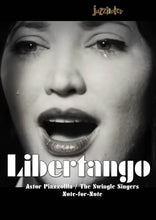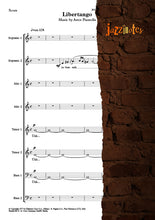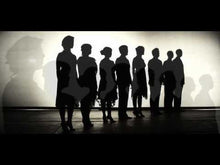Short Description: The sheet
music is a note-for-note transcription of "Libertango" (Astor Piazolla) from the YouTube video "The Swingle Singers Music Video Piazzolla 'Libertango'" for choir a capella, incl. chord symbols and lyrics.
Licensed Territory: worldwide
Instrumentation: Choir a capella (Soprano 1 + 2, Alto 1 + 2, Tenor 1 + 2, Bass 1 + 2)
Interpreters: The Swingle Singers
Music by: Astor Piazzolla
Level: 4 (of 5)
Pages: 41 (19 score + 22 parts)
Order No. 101-760-8006d
Guarantee: yes
Video: Please click on the video icon above!
Songfacts:
The jazzinotes edition is a note-for-note transcription of the fantastic video " Music Video Piazzolla 'Libertango'". The male vocals sometimes imitate the drums. This is transcribed, too. The syllables are included. The chord symbols are notated in the part "Bass 2" that supports lerning the sometimes delicate intonation. The range is quite large: E in Bass 2 and high E in Soprano 1. Therefore these extreme notes may be sung an octave higher or lower.
The a capella octet "The Swingle Singers" was formed 1962 in Paris with Ward Swingle, Anne Germain, Claude Germain, Jeanette Baucomont, Christiane Legrand, Claudine Meunier, Jean-Claude Briodin, and Jean Cussac.
Libertango is perhaps Astor Piazzolla’s most widely known composition, as its famous interpretation I’ve Seen That Face Before from Grace Jones brought it into international charts, as well as radio and television channels.
The title is derived by combining ‘liberdad’ (Spanish for ‘freedom’) with ‘tango’, symbolizing Piazzolla’s break from classical tango and the founding of his own form – Tango Nuevo. This break cannot be understood without taking a look at Piazzolla’s life story. Four years after his birth, his family moved from Argentina to New York. His father was an ardent tango bandoneon player and was friends with Carlos Gardel, among others. Astor, however, was more interested in jazz, and the music of Johann Sebastian Bach. The family moved back to Buenos Aires in 1937. Astor also was able to earn some money by playing tango, but his real goal was to study new classical music. His dream was realized when he won a European scholarship and moved to Paris. During his studies in Paris, he concealed his tango background. He justified later by saying that tango had a very bad reputation as cheap music for the lower classes. The turnaround didn’t occur until his composition teacher Nadia Boulanger (whose most famous students are Aaron Copland and Phillip Glass) encouraged him to leave classical music and pursue a career in tango.
After his return to Argentina, Piazzolla founded Tango Nuevo, which expanded all of the musical parameters of traditional tango, and broke away from the pure dance music. Thus, he is claimed by both jazz and classical genres as one of their own, as he moved away from the dance floor and into the concert hall. The people of his native land did not find this funny – for a time it was not even safe for Piazzolla walk the streets. However, before his death in 1992 he was finally accepted as a national hero of Argentina. Since then, his popularity outside of Argentina has continued to grow. Interpreters of his music include Gidon Kremer, Daniel Barenboim, Giora Feidman, Yo Yo Ma, the Kronos-Quartett, and Al die Meola, among many others.
Transposition:
We can transpose this tune for you. This is how it works:
1. Order it in the original version.
2. Order our article Transposition B.
3. Send an informal email to info@jazzinotes.com (subject:“Transposition”). In the email please indicate the title of the original as well as the key desired.
You’ll receive the transposition within a couple of days as a pdf file you can open using your password for the original version.







